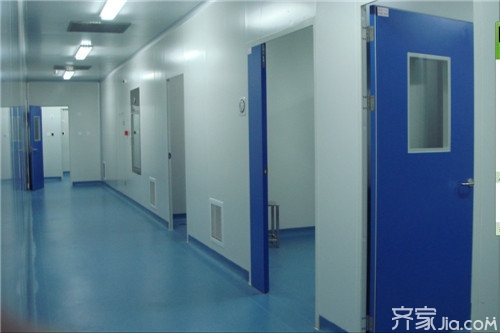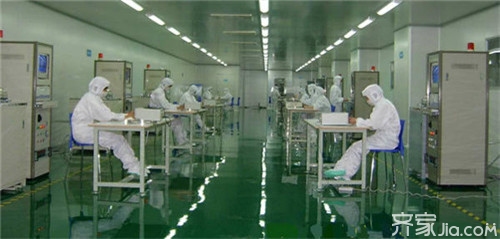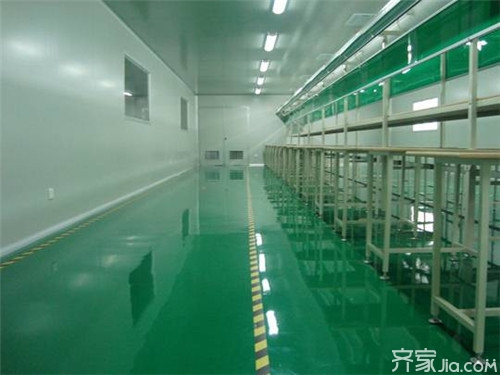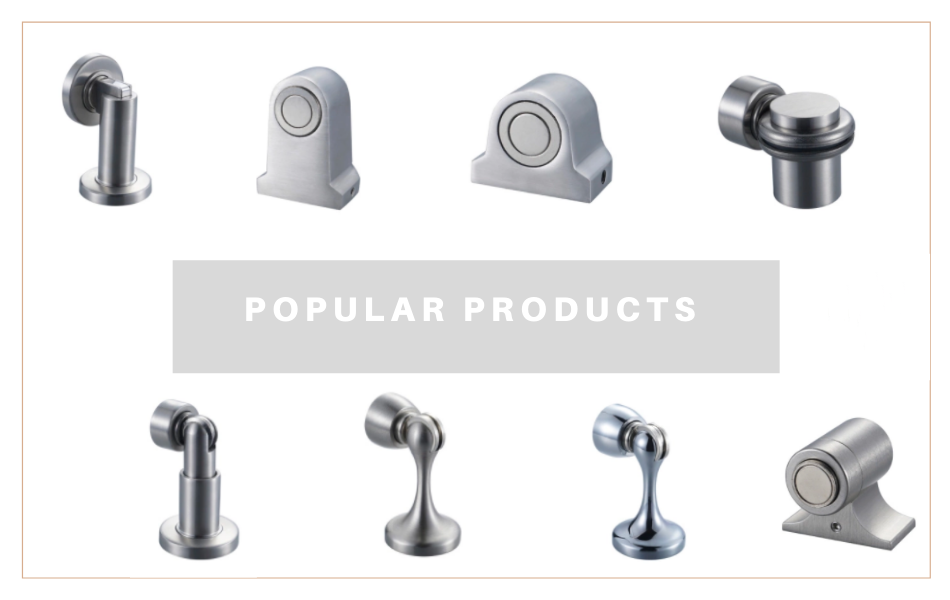How can I buy quality building materials?
Although it is difficult for us to limit our exposure to outdoor pollution, we can significantly improve indoor air quality. Since we spend most of our time indoors, indoor air quality becomes critical to our health. How can we protect our health and environment in a sustainable way? Here's a look at what's going on in the cleanroom.

First, the definition of clean room
A clean room is a room where the concentration of airborne particles is controlled. It is constructed and used in a manner that minimizes the entry, generation, and retention of particles in the room. Room temperature, humidity, pressure and other related parameters are controlled according to requirements (ISO 14644-6)
The most important role of the clean room is to control the cleanliness of the atmosphere and the temperature and humidity of the atmosphere that products (such as silicon chips, etc.) are in contact with, so that the products can be produced and manufactured in a good environmental space. This space is called a clean room. "."
Second, the classification of clean rooms
1. Turbulent Flow
The air enters the clean room from the air-conditioned box through the air duct and the clean room air filter (HEPA), and returns from the partition walls or elevated floors on both sides of the clean room. The air flow is non-linear and irregularly turbulent or turbulent. This type is suitable for clean room grades of 1,000-100,000.
Advantages: Simple structure, system construction cost, and easy expansion of the clean room. In some special-purpose places, dust-free worktables can be used together to improve the clean room level.
Disadvantages: Dust particles caused by turbulent flow floating in the indoor space is not easy to discharge, easy to pollute the process products. In addition, if the system is shut down and then activated, the desire for cleanliness of the demand will often take a long time.
2. Laminar
The laminar airflow moves into a uniform linear shape. The air enters the room with a filter with a coverage of 100%, and is returned by the raised floor or the side walls. This type is suitable for environments where the cleanroom level is higher. Use, generally its clean room level is Class 1~100. Its type can be divided into two kinds:
(1) Horizontal laminar flow type: horizontal air is blown out in one direction from the filter, and the return air system of the opposite side wall returns air. The dust is discharged to the outside with the wind direction, and the pollution is generally serious on the downstream side.
Advantages: simple structure, can become stable within a short time after operation.
Disadvantages: The construction cost is higher than the turbulent flow type, and the indoor space is not easy to expand.
(2) Vertical laminar flow type: The ceiling of the room is completely covered with a ULPA filter, and the air is blown from the top to the bottom to obtain a higher degree of cleanliness. During the manufacturing process, the dust generated by the workers can be rapidly discharged outdoors without affecting Other work areas.
Advantages: Easy to manage, the stable state can be achieved within a short time after the start of operation, and it is not easy to affect the working state or the operator.
Disadvantages: higher construction costs, flexible use of space, ceiling hangers take up space, maintenance and replacement of filters is more troublesome.
3. Mixed Type
The compound type is to combine turbulent flow and laminar flow in combination or in combination to provide locally super clean air.
(1) Clean Tunnel: The HEPA or ULPA filter covers 100% of the process area or work area to improve the cleanliness level to more than 10, which saves installation and operation costs.
This type needs to isolate the working area of ​​the operator from the maintenance of the product and the machine to avoid affecting the work and quality when the machine is repaired. The ULSI process mostly adopts this type.
The clean tunnel has two other advantages: A. It is easy to expand elastically; B. It can be easily performed in the maintenance area when maintaining the equipment.
(2) Clean Tube: Encloses and purifies the automatic production line through which the product flow passes, and raises the cleanliness level to more than 100 levels. Because the product, the operator, and the dust emission environment are isolated from each other, a small amount of air can be provided with good cleanliness, which can save energy, and no manual automated production line is the most suitable for use. The pharmaceutical, food industry and semiconductor industries all apply.
(3) Install a clean spot (clean spot): Raise the cleanliness level of the product processing area in the turbulent clean room of the clean room class of 10,000 to 100,000 to a level of 10 to 1000 or more for use in production; clean benches, Clean work sheds and clean air cabinets are examples of this.
Clean bench: Class Class 1~100.
Clean work shed: To form a small space with a transparent plastic cloth with static electricity prevention in a turbulent clean room space, and to use a separate HEPA or ULPA and air-conditioning blower unit to become a higher level clean room with a rating of 10 ~1000 grade, height of 2.5 meters, covering an area of ​​about 10 square meters or less, four pillars and installation of movable wheels, can be used flexibly.

Third, the composition of the clean room
The composition of the clean room is composed of the following systems (indispensable in the constituent system molecules), otherwise it will not constitute a complete and good quality clean room:
(1) Ceiling system: Ceiling rod, I-Beam or U-Beam, Ceiling grid or Ceiling frame.
(2) Air conditioning system: including air cabin, filter system, windmill, etc.
(3) Partitional wall: Including windows, doors.
(4) Floor: Including raised floor or anti-static Shumei floor.
(5) Lighting: Including fluorescent lamps, yellow lamps, etc.
The main construction of the clean room is usually reinforced or cemented, but no matter what the construction, the following conditions must be met:
A. No cracks will occur due to temperature changes and vibrations;
B. It is difficult to generate fine dust particles, and it is difficult to attach particles;
C. small moisture absorption;
D. In order to maintain the indoor humidity conditions, thermal insulation is high;
Fourth, air purification method
1, the overall purification
Can be divided into laminar flow type and turbulent flow type. Laminar flow means that air flows from one side to the other at the same speed, so that dust or bacteria generated in the room will not spread out to the outside and be pushed out into the air to achieve a good sterilization effect.
(1) High-efficiency filtration and sterilization technology: Air cleaning relies on efficient or ultra-efficient filtration equipment to deliver clean air to specific environments and maintain air cleanliness. Filtration cleanliness principle: 1 network cut-off retention; 2 mesh retention; 3 electrostatic attraction retention; 4 inertial collision and Brownian motion retention. Therefore, the filter cleaning technology is the result of a comprehensive effect.
(2) Filter material structure: Most of the filter materials used in the biological clean room are high-efficiency or ultra-high-efficiency filter materials. The filter materials used include: glass wool filter materials, advanced pulp filter materials, asbestos fiber filters, perchloroethylene fiber filters, etc. . High-efficiency filter materials have a retention rate of 90% to 99% for airborne 0.5 μm particles, and ultra-efficient filter materials can retain more than 99.9% of 0.3 μm particles.
2, local purification
(1) Clean laminar flow hood: The clean laminar flow hood is a local air purification device in the hospital. Generally can constitute a vertical laminar flow method, surrounded by a transparent enclosure. The entire hood can maintain high cleanliness (10,000 to 100 levels) of air. This clean laminar hood can be used for the protection of patients with immunocompromised patients, so it is also called a sterile bed laminar flow hood.
(2) Purifying console: Using horizontal or vertical laminar flow to purify the air in the cabinet, the console can be cleaned to a very high level.
(3) Electrostatic adsorption and sterilization purification technology: Electrostatic adsorption and sterilization is the use of the principle of industrial electrostatic precipitator, and it is innovative in miniaturization technology. 1 using a thin wire discharge electrode and a honeycomb-shaped aluminum box collector to form a level line device; 2 using the image force charged adsorption.
At present, there is a three-stage purification device, namely, pre-filtration - high-efficiency filtration - activated carbon adsorption, combined positive ion electrostatic adsorption sterilization, and the use of high air volume air purification to ensure the number of indoor air purification, and better solve the hospital's key sectors such as The continuous air disinfection in the operating room, ICU, maternal and infant wards, and hemodialysis rooms can make the indoor air clean and clean to 100,000 to 10,000.
(4) Negative ion purification technology: Anion is a negatively charged chemical group, which can undergo reversible changes. The existence of a very short time, there is no ability to kill microorganisms, mainly by charged ions and airborne particles, especially microbial particles In combination, multiple particles form agglomerates that become large and settle quickly, allowing the air to be purified. The negative ions in the air only have certain chemical properties, such as active oxygen ions, etc. They have the ability to invade the protein and kill the microorganisms. Therefore, negative ions have limited ability to purify air, and the clearance rate of microbes in the air can only reach 70%~90%.
Fifth, clean room quotation
1. Cleanroom Quotation Hangzhou Clean Room
Hangzhou Cleanroom Design Co., Ltd. is also in a position to handle cleanrooms. It can well control the cleanliness of products exposed to the atmosphere. The product can be produced and manufactured in a good environment, and the level of dust-free purification requirements with the customer's requirements. Execution standards are based on national standards. For example, the diameter of particles contained in each cubic meter of air, and the related quantities, etc., have certain standards. Related services are also in place. Cleanroom quoted at 780 yuan/100 square meters.
2. Wenzhou Kangding Purification Engineering Co., Ltd.
The company's engineering can achieve particle size parameters of less than 0.3 microns per cubic meter, and the number of particles can be controlled below 3,500. It can be said that such parameters can reach the international dust-free standard A level. Relative to chip-level production and processing, dust-free standards need to be higher than Class A, and are generally production units that produce chips. The company can also achieve a control of fine dust particles of one thousand particles per cubic meter, with particle diameters of 0.5uM and below, which is what we see in the industry as a 1K level. Cleanroom quoted at 880 yuan / 100 square meters.
3. Cleanroom quotation Ningbo dust-free treatment
The clean room processing company in Ningbo can achieve the following effects:
Empty state: For the clean room processing that has been completed and can be put into use, this project has related services and functions. However, it should be noted that there are no operator-related operating devices in the facility. This offer is at 700 yuan / 100 square meters
Static: For various functions, there are settings that are properly set up, can be used according to the settings, and some clean rooms are in use. There are no operators like the above. This offer is at 880 yuan / 100 square meters
Dynamic: This is a clean room that is in normal use. The related services and functions are perfect. There will be equipment and related personnel inside; the personnel can perform normally. This quotation is generally at 1500 yuan / 100 square meters
Sixth, application areas
industry
For the control of inanimate particles. The air pollution is mainly controlled by the airborne particles, and the internal pressure is generally maintained at a positive pressure. It applies to precision machinery industry, electronic industry (semiconductor, integrated circuit, etc.) aerospace industry, high purity chemical industry, atomic energy industry, optical magnetic product industry (disc, film, tape production) LCD (liquid crystal glass), computer hard disk, computer head Production and other industries.
biological
The main control is the contamination of living objects (bacteria) and inanimate particles (dust) on the work object. Can be divided into:
A. General biological clean room: It mainly controls the contamination of microorganism (bacteria) objects. At the same time, its internal materials must withstand the erosion of various sterilizing agents, and the internal pressure is generally guaranteed. Substantially its internal materials should be able to withstand various sterilization processes in industrial clean rooms. Examples: Pharmaceutical industry, hospitals (operating rooms, sterile wards) Food, cosmetics, beverage product production, animal laboratories, physical and chemical laboratory, blood stations, etc.
B. Biology Security Cleanroom: It mainly controls the pollution of external particles and living people from living particles. The interior must maintain negative pressure with the atmosphere. Examples: Bacteriology, Biology, Clean Laboratory, Property Engineering (recombinant genes, vaccine preparation).

Xiao Bian concludes: The relevant knowledge about the clean room Xiaobian is introduced here, I hope to be helpful to everyone. For more relevant information, please continue to pay attention to the information platform of this website. Follow-up will present more exciting content for everyone.
Decoration quotes decoration company quotes decoration quote list
A magnetic door stop is a set of two pieces of hardware. One piece attaches to the bottom inside corner of a door, while the other piece is fixed to the adjacent wall. When these two pieces come in contact, the magnetic door stop may then be able to hold a door open and protect the wall from damage at the same time. Door stops are often available in a variety of finishes, styles and price ranges to suit an individual`s specific needs.
Once both pieces of hardware have been successfully installed, the two pieces should [catch" when the door is open. This is because the two magnets have opposite, attractive forces strong enough to hold a door open. A magnetic door stop is, however, usually weak enough that a simple tug on the door should separate the magnets, which allows the door to close when necessary.

Magnetic Door Stop Lowes,Flush Magnetic Door Stopper,Magnetic Door Stopper Price,Black Magnetic Door Stop
Leader Hardware Manufacturer Limited , https://www.leaderhardwarecn.com